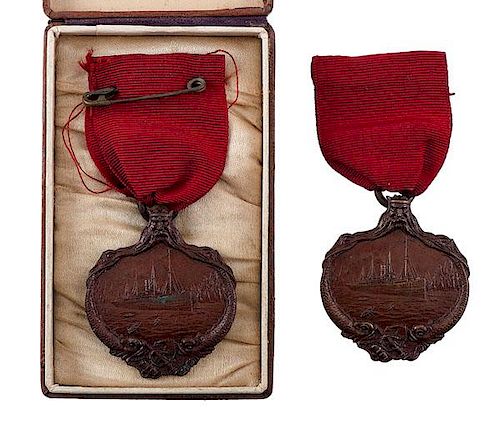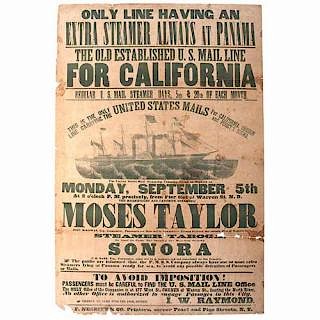Bronze RMS Carpathia Medals Presented to Mr. & Mrs. Ogden, Plus ALS from Captain Arthur Rostron
About Seller
6270 Este Ave.
Cincinnati , OH 45232
United States
With offices in Cincinnati, Cleveland and Denver, Cowan’s holds over 40 auctions each year, with annual sales exceeding $16M. We reach buyers around the globe, and take pride in our reputation for integrity, customer service and great results. A full-service house, Cowan’s Auctions specializes in Am...Read more
Two ways to bid:
- Leave a max absentee bid and the platform will bid on your behalf up to your maximum bid during the live auction.
- Bid live during the auction and your bids will be submitted real-time to the auctioneer.
Bid Increments
| Price | Bid Increment |
|---|---|
| $0 | $25 |
| $500 | $50 |
| $1,000 | $100 |
| $2,000 | $250 |
| $5,000 | $500 |
| $10,000 | $1,000 |
| $20,000 | $2,500 |
| $50,000 | $5,000 |
| $100,000 | $10,000 |
About Auction
Jun 10, 2016 - Jun 11, 2016
Cowan's Auctions dawnie@cowans.com
- Lot Description
Bronze RMS Carpathia Medals Presented to Mr. & Mrs. Ogden, Plus ALS from Captain Arthur Rostron
Lot of 3, featuring 2 bronze medals presented to RMS Carpathia passengers Louis Ogden and his wife Augusta in recognition of gallant and heroic services from the survivors of the SS Titanic on April 15, 1912 in addition to a letter of presentation written to Mr. and Mrs. Ogden and signed by Carpathia Captain A.H. Rostron on behalf of the Titanic Committee, September 30, 1912, on RMS Carpathia letterhead.
The face of each medal shows a nautical scene with Poseidon and his beard entwined with two sea serpents that surround an engraving of the Carpathia at sea, and the reverse includes the presentation inscription: Presented to the Captain, Officers, and Crew of the RMS "Carpathia" in Recognition of Gallant and Heroic Services from the Survivors of the S.S. "Titanic" April 15th, 1912, marked by Dieges & Clust, NY. Each medal is approx. 1.25 x 1.5 in., with original ribbon, approx. 3 in. ln. One medal is accompanied by the original box.
A total of 320 of these medals were produced, mostly in bronze, with officers receiving a silver version and Captain Rostron receiving a gold version. While the medals were not inscribed to the recipients, some had their names added later.
RMS Carpathia Passengers Augusta and Louis M. Ogden,
Exceptional Collection of Photographs, Medals, Correspondence and More Related to the Titanic Rescue
Lots 229-234
Louis M. Ogden (1867-1946) was a member of the Tuxedo Park, NY elite. According to family lore he was one of Griswold Lorillard’s rebellious young friends who wore Lorillard’s father’s scandalous, modified “tailless” black jackets (the tuxedo) to The Tuxedo Club’s first annual Autumn Ball. Ogden was a Columbia graduate and lawyer. Later, he became Vice President and Director of the Ogden Lumber Co. and Director of the East River Mill & Lumber Co.
Like many enormously wealthy men, he traveled the world to exhilarating and exotic locations. In 1901, he and his wife Augusta visited Spain, Portugal, Brazil, Uruguay and the Argentine Republic. He then went on an expedition along the eastern slope of the Andes into Bolivia, travelling 500 miles by mule. He spent considerable time among the Indians, such as the Matacos, Chiriquanos, and Tobas, on the western edge of the "Gran Chaco." In 1904, Ogden made two visits to Cuba.
In 1911, Ogden bought a new camera for his next world tour through Algiers, the Sahara, Spain, Italy, Argentina, Gibraltar, Switzerland, Greece, and Austria. In the middle of his excursion, a surprising and unplanned event occurred—a rescue!
On a clear, April morning in 1912, aboard the RMS Carpathia, Ogden rushed to his quarters to retrieve his new camera. On the horizon, several lifeboats appeared carrying Titanic survivors. Ogden photographed the oncoming emergency boats No. 1, 6, and 14, and listed the names of several lifeboat passengers in his photograph album (Lot 229), which included: The Unsinkable Molly Brown, Quartermaster Robert Hichens, and 5th Officer Harold Lowe. As the Carpathia traveled to the site of the wreck, Ogden expected to see scores of bodies; however, only a sea of cork pieces, an overturned lifeboat, and a few chairs remained. He photographed the desolate scene with the icebergs floating ominously in the distance. He also captured a scene involving Hoisting Titanic boats on board, as well as at least 2 views of the SS Californian in the distance, which was a British Leyland Line steamship best known for its inaction during the sinking of the Titanic despite being the closest ship in the area.
Curious about the sea of cork and lack of remains at the site of the Titanic disaster, Ogden grabbed a few pieces of floating debris and “cut up” some of the Titanic life belts, which contained “a poor quality cork” (April 20, 1912) (Lot 230). In reference to the life belts he saw, Ogden wrote to another passenger, Dr. Frank Blackmarr:
“The bodies that were picked up a week later were found floating with belts properly adjusted. In these circumstances is it not fair to assume that the belts were constructed with improper materials which, becoming water- logged, allowed the bearers to sink only to arise later owing to natural causes?” (Paris Herald, August 11, 1912).
Roughly 1,526 people died but various ships recovered only several hundred bodies. Contrary to Blackmarr and Ogden’s claims, several seamen aboard the lifeboats reported that there were scores of bodies surrounding them before their rescue. Seaman Frank O. Evans testified during the British Inquiry, “I was afraid to look over the sides because it might break my nerves down.” Seaman Joseph Scarrot said, “There were more bodies than there was wreckage . . . We made sail and sailed back to take our other boats in tow that could not manage themselves at all. We made sail then, but just as we were getting clear of the wreckage we sighted the ‘Carpathia's’ lights” (http://www.encyclopedia-titanica.org/titanic-where-were-the-bodies.html). Scholars say most of the people who died were probably in life jackets and a storm scattered the bobbing corpses, sweeping them far to sea in a line 50 miles long. By daylight, the storm cleared and most of the bodies might have disappeared, which could explain why Blackmarr and Ogden saw so few human remains.
Provenance: Descended Directly in the Family of RMS Carpathia Passengers Augusta and Louis M. OgdenBoth medals retain their original red ribbon and brass pin, one medal is still in its original box from the Dieges & Clust jewelers, NY.Condition
- Shipping Info
-
SHIPPING. At the request of the buyer, Cowan's will authorize the shipment of purchased items. Shipments usually occur within two weeks after payment has been received. Shipment is generally made via UPS Ground service. Unless buyer gives special instructions, the shipping method shall be at the sole discretion of Cowan's Auctions, Inc.. Cowan's is in no way responsible for the acts or omissions of independent handlers, packers or shippers of purchased items or for any loss, damage or delay from the packing or shipping of any property.
-
- Buyer's Premium



 EUR
EUR CAD
CAD AUD
AUD GBP
GBP MXN
MXN HKD
HKD CNY
CNY MYR
MYR SEK
SEK SGD
SGD CHF
CHF THB
THB













